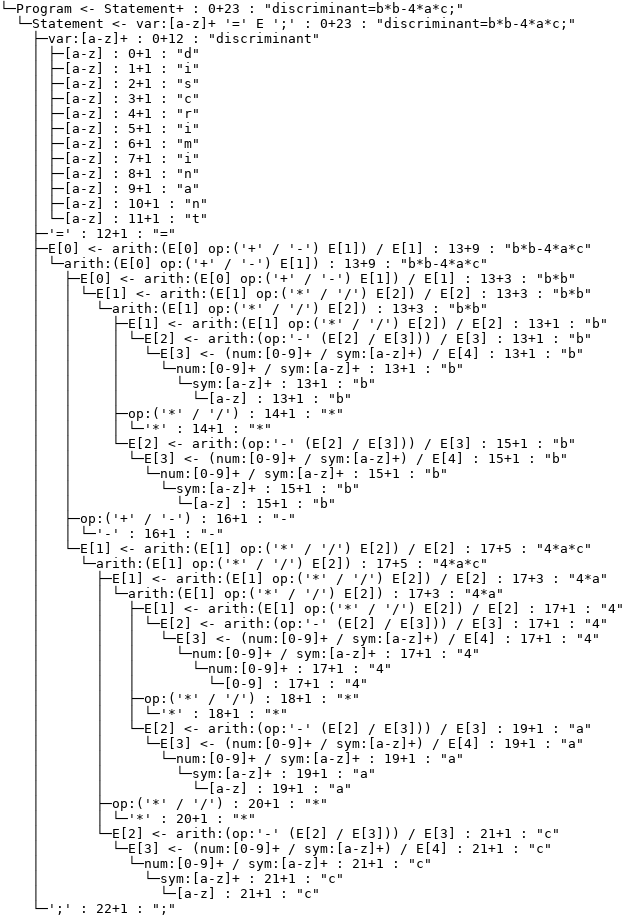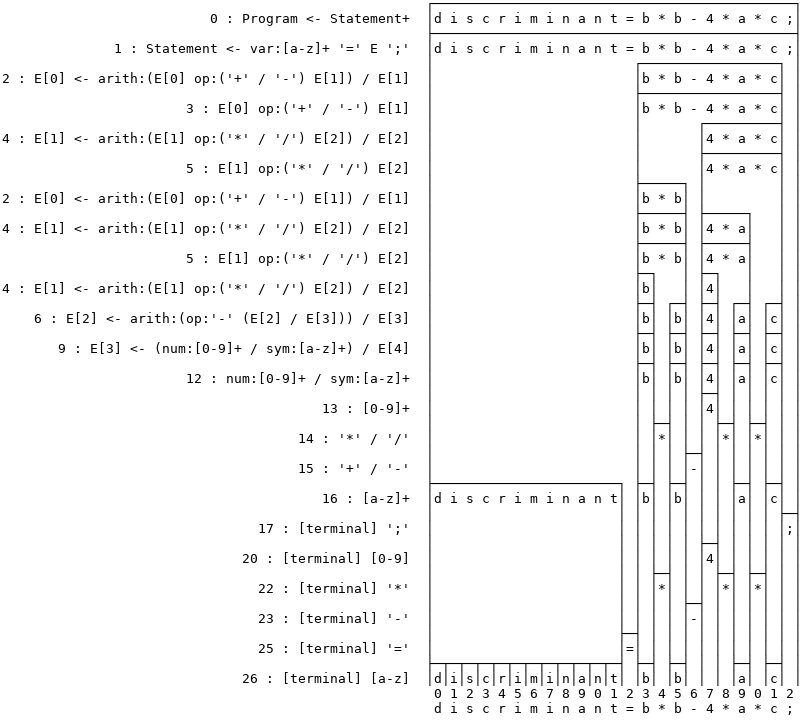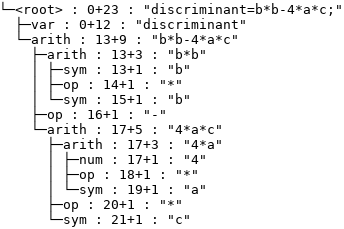Layout-sensitive pika parser
This version of the pika parsing algorithm is based on the reference implementation of the pika parsing algorithm, described in the paper:
It has, however, been migrated to Kotlin from the original Java. The ultimate goal of this implementation is to allow for parsing whitespace-sensitive layout syntax as is used in languages such as Haskell, F#, Elm, and Python.
From the README of the reference implementation project:
Pika parsing is the inverse of packrat parsing: instead of parsing top-down, left to right, pika parsing parses bottom-up, right to left, using dynamic programming. This reversed parsing order allows the parser to directly handle left-recursive grammars, and allows the parser to optimally recover from syntax errors.
Example usage
Parsing code
The following examples are in Kotlin, but follow the examples given on the reference implementation README at [https://github.com/lukehutch/pikaparser]
fun main() {
val grammarSpec = Files.readAllLines(Paths.get("arithmetic.grammar")).joinToString()
val grammar = MetaGrammar.parse(grammarSpec)
val input = Files.readAllLines(Paths.get("arithmetic.input")).joinToString()
val memoTable = grammar.parse(input)
val topRuleName = "Program"
val recoveryRuleNames = listOf(topRuleName, "Statement")
ParserInfo.printParseResult(topRuleName, grammar, memoTable, input, recoveryRuleNames, false)
}Grammar description file: arithmetic.grammar
Program <- Statement+;
Statement <- var:[a-z]+ '=' E ';';
E[4] <- '(' E ')';
E[3] <- num:[0-9]+ / sym:[a-z]+;
E[2] <- arith:(op:'-' E);
E[1,L] <- arith:(E op:('*' / '/') E);
E[0,L] <- arith:(E op:('+' / '-') E);
The rules are of the form RuleName <- [ASTNodeLabel:]Clause;
Clauses can be of the form:
X Y Zfor a sequence of matches (Xshould match, followed byY, followed byZ), i.e.SeqX / Y / Zfor ordered choice (Xshould match, or if it doesn't,Yshould match, or if it doesn't'Zshould match) , i.e.FirstX+to indicate thatXmust match one or more times, i.e.OneOrMoreX*to indicate thatXmust match zero or more times, i.e.ZeroOrMoreX?to indicate thatXmay optionally match, i.e.Optional&Xto look ahead and requireXto match without consuming characters, i.e.FollowedBy!Xto look ahead and require that there is no match (the logical negation of&X), i.e.NotFollowedBy
The number in the optional square brackets after the rule name is the precedence, followed by an optional associativity modifier (,L or ,R).
Input string to parse: arithmetic.input
discriminant=b*b-4*a*c;
Generated parse tree:
Alternative view of generated parse tree:
Generated Abstract Syntax Tree (AST):
Printing syntax errors
To find syntax errors, call:
/* This call to getSyntaxErrors returns a value of type NavigableMap<Integer, Entry<Integer, String>>.
*
* The first two parameters designate the grammar and the input.
*
* The remaining arguments are a varargs parameter listing the names of all the grammar rules
* that should span all the designated input.
*/
val syntaxErrors =
memoTable.getSyntaxErrors(grammar, input, "Program", "Statement", "Expr");Any character range that is not spanned by a match of one of the named rules is returned in
the result as a syntax error. You can print out the characters in those ranges as syntax errors. The entries
in the returned NavigableMap have as the key the start position of a syntax error (a
zero-indexed character position from the beginning of the string), and as the value an
entry consisting of the end position of the syntax error and the span of the input between
the start position and the end position.
Error recovery
You can recover from syntax errors by finding the next match of any grammar rule of interest after the syntax error (i.e. after the end of the last character matched by a previous grammar rule). For example:
val programEntries: NavigableMap<Int, Match> = grammar.getNavigableMatches("Program", memoTable)
var matchEndPosition = 0
if (programEntries.isNotEmpty()) {
val programMatch = programEntries.firstEntry().value
if (programMatch != null) {
val startPos = programMatch.memoKey.startPos
val length: Int = programMatch.length
matchEndPosition = startPos + length
}
}
if (matchEndPosition < input.length) {
val statementEntries: NavigableMap<Int, Match> = grammar.getNavigableMatches("Statement", memoTable)
val nextStatementEntry = statementEntries.ceilingEntry(matchEndPosition)
if (nextStatementEntry != null) {
val nextStatementMatch = nextStatementEntry.value
// ...
}
}


